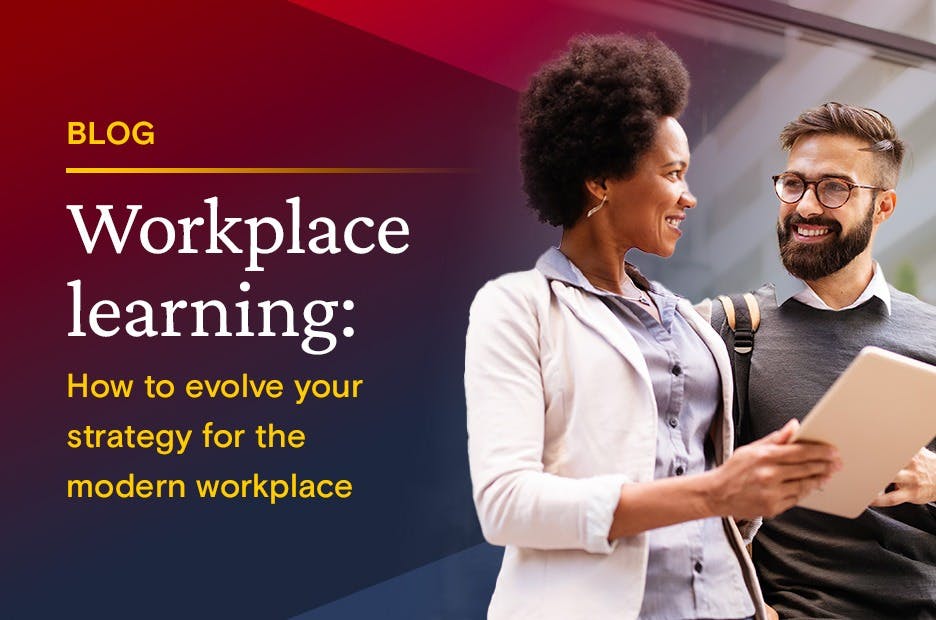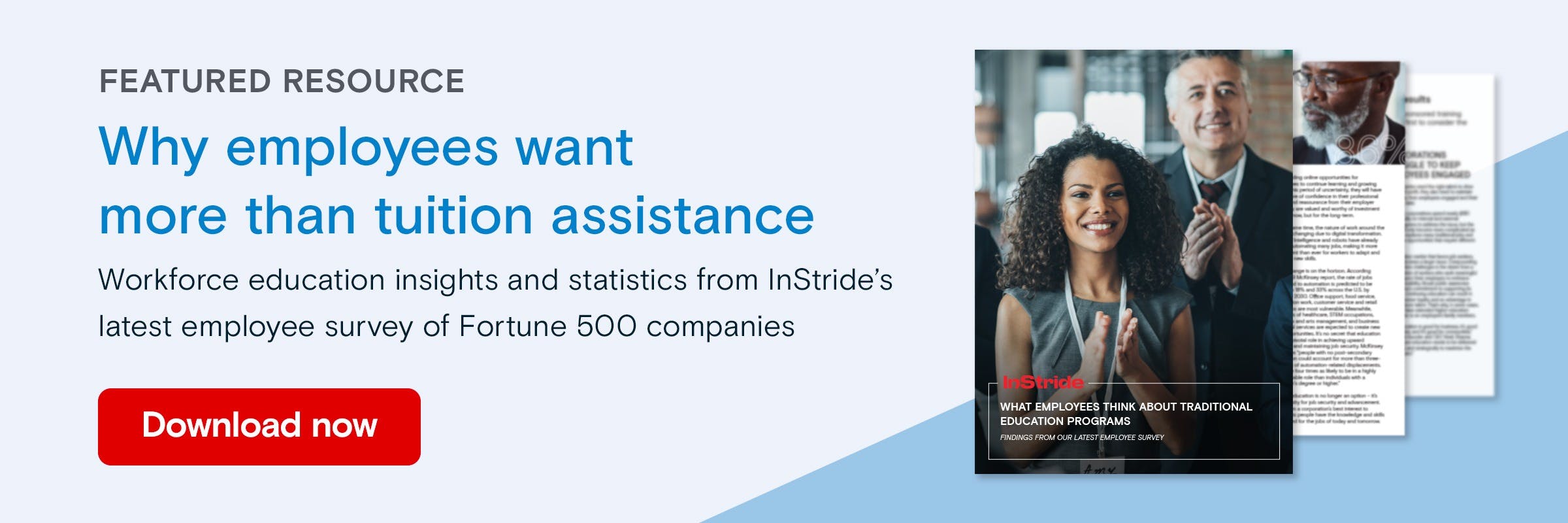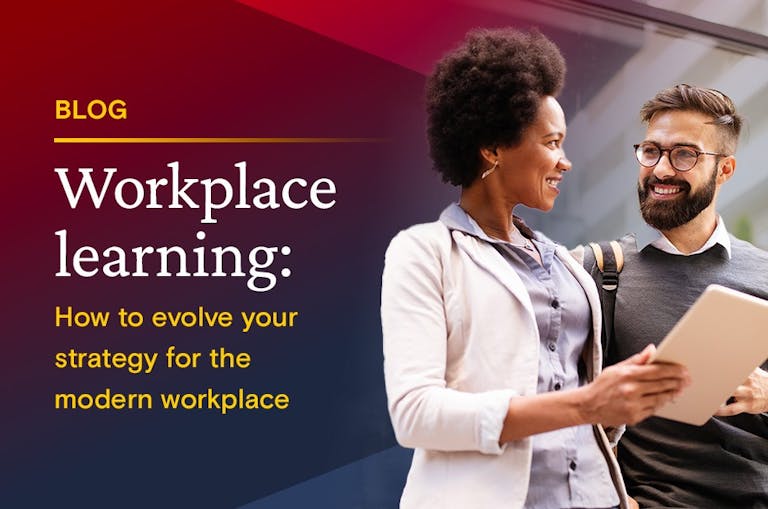Employee education, training and development continue to be a top priority for today’s HR and corporate leaders. From lending a competitive advantage to creating a more equitable work environment, there are a variety of benefits to organizations that prioritize continuous workplace learning for their employees.
Although you may already have robust learning initiatives in place, it’s critical to revisit these strategies and ensure they continue to evolve to meet the changing needs of your business and team members. As you prepare for the future of work, organizations need to view workplace learning as a solution with numerous strategic applications, including the potential to make a big impact on the growth of your business when executed correctly.
Let’s take a look at what workplace learning looks like in practice and highlight key elements to consider when evolving your workplace learning strategy for today and the future.
Modern workplace learning
Let’s take a closer look at some of the specific workplace learning solutions that are prioritized by companies today.
Developing flexible upskilling and reskilling programs for your workforce
Accelerated technological development and ever-changing world circumstances constantly affect the skills required to stay competitive. A recent InStride workplace learning survey shows that 68 percent of business leaders identified current skills gaps across their employee base — further demonstrating the need for skill-building initiatives.
Reskilling and upskilling programs come in a variety of formats that largely depend on the type of skills required for advancement. For example, an employee that’s looking to sharpen their technical coding skills could take advantage of a six-week development online course. On the other hand, an individual that wants to get promoted into management might consider a long-term option and enroll in an MBA program at a university.
No matter the format, it’s most important to consider that the needs of every employee learner are different. The skill-building solution you land on has to be flexible and comprehensive enough to work for all team members — from the frontline to management positions.
Leveraging digital education solutions for workplace learning
Advancements in technology have not only changed the way people do business but also the way that people learn. Today, employees are no longer tied to a physical classroom like they were before.
The widespread adoption of online education puts companies in a unique position to provide employees with a vast array of options to meet their unique learning styles and provide them with the flexibility to learn from anywhere. This modern approach makes education much simpler to integrate learning into the busy lives of working adult learners.
Online learning formats can include:
- Videos
- Interactive courses
- Podcasts
- E-books
- Live or pre-recorded lectures
- Gamified tests and quizzes
Online learning solutions are equally beneficial for businesses, making it simpler to measure the impact of their workplace learning strategies and lessening administrative burdens.
Thinking beyond tuition reimbursement or assistance programs
Employee tuition reimbursement or assistance programs help employees earn degrees, credentials or certifications from various academic institutions. While it’s true that helping to pay for your workers’ education can offer them life-changing access to learning, many traditional tuition assistance programs are often ineffective. This is due to a variety of factors, including lack of employee engagement with the program, complex reimbursement policies and financial barriers.
Instead, the most innovative businesses are thinking beyond traditional tuition reimbursement programs and implementing workforce education solutions that remove these barriers and are easily accessible to all employees, regardless of their financial situation or other circumstances.
Workplace learning opportunities and strategies
Below, you’ll find a list of workplace learning opportunities that you should consider offering to your employees:
- Apprenticeships
Highly specialized leaders at your organization can directly train employees, or apprentices, on hard or soft skills related to their area of expertise. - Mentorships
One-on-one instruction opportunities between junior and senior staff members can help nurture a mutually beneficial relationship that cultivates professional and skills development. - Workforce education programs
Invest in an education program that provides employees the ability to earn degrees, credentials or certificates from an academic institution. - Independent learning
Encourage employees to seek out ways to learn informally outside of the workplace. This can include access to volunteering opportunities or industry-relevant events and conferences. - Training
Leverage internal or external experts to host workshops, lectures or seminars around relevant skills-based topics to support learning and knowledge sharing.
Although you may already have some (or all) of these practices in place, it’s important to revisit them periodically and assess their effectiveness. For example, take a look at your training materials. Are they still relevant to your employees? Or are they outdated and in need of a content refresh?
Importance of continuous learning at work
In many cases, formalized employee learning processes “end” after the initial onboarding process or are followed up with infrequent, intermittent re-training sessions. This may be effective at enhancing employee skills in the short term, but it’s not enough to give your business a competitive advantage or stay ahead of disruption.
Instead, organizations should view workplace learning as an ongoing process that contributes to continuous employee development rather than a “one-and-done” effort. Continuous education programs invest in the long-term success of employee education and the retention of skills and knowledge by providing relevant, ongoing learning opportunities.
Some tangible benefits of continuous learning in the workplace include:
- Internal leadership talent pipeline development
Future-proof your business by having promising talent skilled and ready to take on increased responsibilities in advanced leadership positions. - Improved employee engagement
Your workers never stagnate or feel stuck in dead-end jobs if they are constantly learning, growing and advancing. A continuous cycle of skills development followed by recognition of successful learning boosts morale and helps your employees feel good about their work. - Turnover reduction
94 percent of employees say they would stay at their current job if the company offered better learning opportunities. Incorporating education into daily life at your organization motivates workers to stay productive and saves time and money that’s otherwise compromised by high turnover rates.
Read more: Growing existing skills is integral to the current and future success of your workforce. Not sure where to start? Pick up actionable tactics in this article on how to upskill your employees.
How to measure your workplace learning strategy
As with any business strategy, it’s vital to keep a close eye on the health and effectiveness of your workplace learning initiatives after they are implemented. If you’re going to take the time and resources to make workplace learning central to your people strategy, you need to make sure those efforts are actually paying off.
Here are some of the most important talent development metrics to track:
- Skills retention
How long after training do employees keep acquired knowledge and skills? Do they require additional training to maintain information and abilities? - Time to proficiency
How long does it take your employees to integrate training? How quickly are new skills being learned? How well are these skills being performed? - Knowledge transfer
How effectively are your employees applying learning to on-the-job activities? Is their understanding of the training purely theoretical or are they successfully using these skills in their respective roles? - Engagement
What percentage of your employees are taking advantage of your education initiatives? What is the return on investment (ROI) on your learning investments?
How to create a learning culture in the workplace
A critical component of successful workplace education programs is the need to develop a culture of learning. Your employees are far more likely to take advantage of educational resources if you’re able to cultivate a work environment that’s primed for growth and encourages learning.
Here are several ways you can better integrate learning into your company culture:
- Celebrate success: Keep your employees motivated by acknowledging their accomplishments.
- View learning as a business strategy: Align employee development with the larger goals of your company to ensure your efforts drive growth and deliver a ROI.
- Start with the C-suite: Company culture starts at the top of an organization — this means upper management should prioritize their own learning and development alongside everyone else.
- Prioritize skill-building: Boost employee confidence by committing to skill-building programs that can help them get to the next level in their career. Be transparent and provide team members with tangible outcomes to encourage participation.
- Encourage communication: Empower employees at all levels to share their learning experiences and support one another in their mutual growth.
The key to impactful workplace learning
The benefits of workforce education and learning speak for themselves, but it needs to be correctly implemented and effectively utilized in order to be successful. A strategic approach to workplace learning, combined with the right technology, allows you to cultivate a thriving work culture that values employee growth and sets your entire organization up for long-term success.
Ready to take action on workplace learning? Connect with one of InStride’s education experts today.


